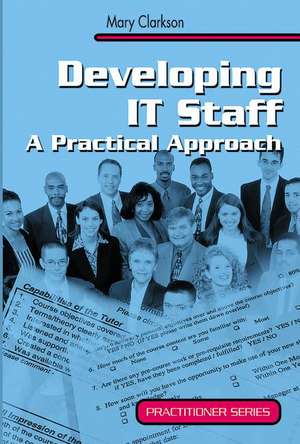Developing IT Staff: A Practical Approach: Practitioner Series
Autor Mary Clarksonen Limba Engleză Paperback – 22 iun 2001
Din seria Practitioner Series
- 20%
 Preț: 337.52 lei
Preț: 337.52 lei - 20%
 Preț: 645.14 lei
Preț: 645.14 lei - 20%
 Preț: 333.54 lei
Preț: 333.54 lei - 20%
 Preț: 336.86 lei
Preț: 336.86 lei - 20%
 Preț: 332.24 lei
Preț: 332.24 lei - 20%
 Preț: 326.28 lei
Preț: 326.28 lei - 20%
 Preț: 344.76 lei
Preț: 344.76 lei - 20%
 Preț: 330.56 lei
Preț: 330.56 lei - 20%
 Preț: 333.04 lei
Preț: 333.04 lei - 20%
 Preț: 336.67 lei
Preț: 336.67 lei - 15%
 Preț: 646.94 lei
Preț: 646.94 lei - 20%
 Preț: 330.10 lei
Preț: 330.10 lei - 20%
 Preț: 332.24 lei
Preț: 332.24 lei - 20%
 Preț: 329.76 lei
Preț: 329.76 lei - 20%
 Preț: 327.77 lei
Preț: 327.77 lei - 20%
 Preț: 328.27 lei
Preț: 328.27 lei - 20%
 Preț: 341.95 lei
Preț: 341.95 lei - 20%
 Preț: 328.42 lei
Preț: 328.42 lei - 20%
 Preț: 331.58 lei
Preț: 331.58 lei - 20%
 Preț: 326.13 lei
Preț: 326.13 lei - 15%
 Preț: 647.08 lei
Preț: 647.08 lei - 20%
 Preț: 355.14 lei
Preț: 355.14 lei
Preț: 383.71 lei
Nou
Puncte Express: 576
Preț estimativ în valută:
73.43€ • 76.38$ • 60.62£
73.43€ • 76.38$ • 60.62£
Carte tipărită la comandă
Livrare economică 15-29 aprilie
Preluare comenzi: 021 569.72.76
Specificații
ISBN-13: 9781852334338
ISBN-10: 1852334339
Pagini: 220
Ilustrații: XVII, 195 p. 26 illus.
Dimensiuni: 155 x 235 x 12 mm
Greutate: 0.31 kg
Ediția:Softcover reprint of the original 1st ed. 2001
Editura: SPRINGER LONDON
Colecția Springer
Seria Practitioner Series
Locul publicării:London, United Kingdom
ISBN-10: 1852334339
Pagini: 220
Ilustrații: XVII, 195 p. 26 illus.
Dimensiuni: 155 x 235 x 12 mm
Greutate: 0.31 kg
Ediția:Softcover reprint of the original 1st ed. 2001
Editura: SPRINGER LONDON
Colecția Springer
Seria Practitioner Series
Locul publicării:London, United Kingdom
Public țintă
Professional/practitionerCuprins
1 Background.- 1.1 Introduction.- 1.2 Main Points of this Chapter.- 1.3 Training and Education.- 1.4 How Adults Learn.- 1.5 Stakeholders.- 1.6 Team Leader’s Role in Training.- 1.7 Summary.- 2 Spotting the Training Need and Getting SMART.- 2.1 Introduction.- 2.2 Main Points of this Chapter.- 2.3 Perceived Training Need.- 2.4 Checking Out the Real Training Need.- 2.5 SMART Objectives.- 2.6 Action Plan.- 2.7 Summary.- 3 Choosing between Training Methods — Short-term Options.- 3.1 Introduction.- 3.2 Main Points of this Chapter.- 3.3 Short Taught Course.- 3.4 Self-Study.- 3.5 On-the-job Training.- 3.6 Summary.- 4 Choosing between Training Methods — Long-term Options.- 4.1 Introduction.- 4.2 Main Points of this Chapter.- 4.3 Mentoring.- 4.4 Accreditations.- 4.5 Higher Education.- 4.6 Summary.- 5 Learner Support.- 5.1 Introduction.- 5.2 Main Points of this Chapter.- 5.3 Pre-Training Support.- 5.4 Post-Training Support.- 5.5 Coaching the Learner.- 5.6 Action Groups.- 5.7 Summary.- 6 Evaluation: Was It Worth It?.- 6.1 Introduction.- 6.2 Main Points of this Chapter.- 6.3 Why Evaluate: What Evaluation is For.- 6.4 When and How to Evaluate.- 6.5 Remedies When Training Did Not Work.- 6.6 Is It Worth Evaluating?.- 6.7 Summary.- 7 Career Development.- 7.1 Introduction.- 7.2 Main Points of this Chapter.- 7.3 Experience as a Development Method.- 7.4 Defining Job Roles.- 7.5 Moving From Role to Role.- 7.6 Developing Within a Role.- 7.7 Support From Professional Societies.- 7.8 Summary.- 8 Skill Assessment.- 8.1 Introduction.- 8.2 Main Points of this Chapter.- 8.3 Technical Testing.- 8.4 Performance Appraisals.- 8.5 Psychometric Testing.- 8.6 Assessment Centres and Development Centres.- 8.7 Summary.- 9 Soft Skills — Can They Be Taught?.- 9.1 Introduction.- 9.2 Main Points of thisChapter.- 9.3 What Are Soft Skills?.- 9.4 Which Ones Are Important?.- 9.5 Developing Soft Skills.- 9.6 Challenges We Face.- 9.7 Summary.- 10 Wider Organizational Picture.- 10.1 Introduction.- 10.2 Main Points of this Chapter.- 10.3 Organizational Structure and Impact on Training.- 10.4 About Large Training Programmes.- 10.5 Setting Up Large Training Programmes.- 10.6 Training in the Smaller IT Department.- 10.7 Summary.- 11 Trainees: New Entrants to IT.- 11.1 Introduction.- 11.2 Main Points of this Chapter.- 11.3 What Trainees Need to Know.- 11.4 How to Develop Trainees.- 11.5 Organizing the Training.- 11.6 Graduate Entrants.- 11.7 Mature Entrants.- 11.8 Encouraging Trainees.- 11.9 Summary.- 12 Into the Future.- 12.1 Introduction.- 12.2 Main Points of this Chapter.- 12.3 Planning for Future Skills.- 12.4 Analysing Future Needs.- 12.5 Carrying Out the Training.- 12.6 Supporting Self Development.- 12.7 Does the Future Ever Come?.- 12.8 Summary.
Caracteristici
SPECIFICALLY ADDRESSES TRAINING AND DEVELOPMENT ISSUES IN THE CONTEXT OF AN IT DEPARTMENT OF TECHNICAL SPECIALISTS A PRACTICAL GUIDE DESIGNED TO PROVIDE EASY REFERENCE AS DISCUSSING RELEVANT ISSUES Includes supplementary material: sn.pub/extras

















